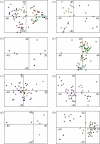The population genetics of mimetic diversity in Heliconius butterflies
- PMID: 18077248
- PMCID: PMC2596806
- DOI: 10.1098/rspb.2007.1378
The population genetics of mimetic diversity in Heliconius butterflies
Abstract
Theory predicts strong stabilizing selection on warning patterns within species and convergent evolution among species in Müllerian mimicry systems yet Heliconius butterflies exhibit extreme wing pattern diversity. One potential explanation for the evolution of this diversity is that genetic drift occasionally allows novel warning patterns to reach the frequency threshold at which they gain protection. This idea is controversial, however, because Heliconius butterflies are unlikely to experience pronounced population subdivision and local genetic drift. To examine the fine-scale population genetic structure of Heliconius butterflies we genotyped 316 individuals from eight Costa Rican Heliconius species with 1428 AFLP markers. Six species exhibited evidence of population subdivision and/or isolation by distance indicating genetic differentiation among populations. Across species, variation in the extent of local genetic drift correlated with the roles different species have played in generating pattern diversity: species that originally generated the diversity of warning patterns exhibited striking population subdivision while species that later radiated onto these patterns had intermediate levels of genetic diversity and less genetic differentiation among populations. These data reveal that Heliconius butterflies possess the coarse population genetic structure necessary for local populations to experience pronounced genetic drift which, in turn, could explain the origin of mimetic diversity.
Figures



References
-
- Beltrán M, Jiggins C.D, Bull V, Linares M, Mallet J, McMillan W.O, Bermingham E. Phylogenetic discordance at the species boundary: comparative gene genealogies among Heliconius butterflies. Mol. Biol. Evol. 2002;19:2176–2190. - PubMed
-
- Blum M.J. Rapid movement of a Heliconius hybrid zone: evidence for phase III of Wright's shifting balance theory? Evolution. 2002a;56:1992–1998. - PubMed
-
- Blum, M. J. 2002b Neotropical hybrid zone stability and formation. PhD thesis, Duke University, Department of Zoology.
-
- Bonnet E, Van de Peer Y. ZT: a software tool for simple and partial Mantel tests. J. Stat. Softw. 2002;7:1–12.
-
- Brower A.V.Z. Phylogeny of Heliconius butterflies inferred from mitochondrial DNA sequences (Lepidoptera: Nymphalidae) Mol. Phylogenet. Evol. 1994a;3:159–174. doi:10.1006/mpev.1994.1018 - DOI - PubMed
Publication types
MeSH terms
LinkOut - more resources
Full Text Sources
Other Literature Sources

